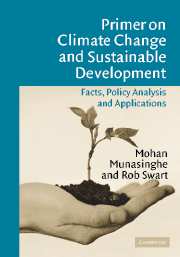Book contents
- Frontmatter
- Contents
- Foreword
- Preface
- 1 Climate change: scientific background and introduction
- 2 Future scenarios of development and climate change
- 3 Framework for making development more sustainable (MDMS): concepts and analytical tools
- 4 Interactions between climate and development
- 5 Adaptation to climate change: concepts, and linkages with sustainable development
- 6 Vulnerability, impacts, and adaptation by sectors and systems
- 7 Vulnerability, impacts, and adapation by geographic region
- 8 Mitigating climate change: concepts and linkages with sustainable development
- 9 Mitigation measures: technologies, practices, barriers, and policy instruments
- 10 Assessment of mitigation costs and benefits
- 11 Climate change and sustainable development: a synthesis
- Index
- References
3 - Framework for making development more sustainable (MDMS): concepts and analytical tools
Published online by Cambridge University Press: 25 December 2009
- Frontmatter
- Contents
- Foreword
- Preface
- 1 Climate change: scientific background and introduction
- 2 Future scenarios of development and climate change
- 3 Framework for making development more sustainable (MDMS): concepts and analytical tools
- 4 Interactions between climate and development
- 5 Adaptation to climate change: concepts, and linkages with sustainable development
- 6 Vulnerability, impacts, and adaptation by sectors and systems
- 7 Vulnerability, impacts, and adapation by geographic region
- 8 Mitigating climate change: concepts and linkages with sustainable development
- 9 Mitigation measures: technologies, practices, barriers, and policy instruments
- 10 Assessment of mitigation costs and benefits
- 11 Climate change and sustainable development: a synthesis
- Index
- References
Summary
Preliminary ideas
World decision-makers are looking for new solutions to many critical problems, including traditional development issues (e.g. economic stagnation, persistent poverty, hunger, malnutrition, and illness), as well as newer challenges, e.g. worsening environmental degradation and accelerating globalization. One key approach that is receiving growing attention is based on the concept of sustainable development or ‘development which lasts’. Following the 1992 Earth Summit in Rio de Janeiro and the adoption of the UN's Agenda 21, sustainable development has become well accepted worldwide (UN 1993; WCED 1987).
A key question for policy-makers is: how can we make development more sustainable? In order to help them address this question, analysts have a number of concepts and tools at their disposal. In this chapter, we discuss generic approaches, including the sustainable development triangle, integrative methods (e.g. optimality and durability) and other elements, e.g. indicators, cost–benefit analysis, and multicriteria analysis. Externalities, valuation techniques, and discounting are explained. In Chapter 5, we expand on the use of cost–benefit analysis for adaptation to climate change at the project and more aggregate level. In addition to cost–benefit analysis and multicriteria analysis, we also discuss other techniques in Chapter 5. The latter techniques include methods that have been applied specifically in the context of mitigation options, notably the so-called ‘safe-landing’ and ‘tolerable windows’ approaches, and cost-effectiveness analysis.
Both development and sustainable development are wide-ranging topics that have been researched thoroughly in past decades, and boast an extensive literature.
- Type
- Chapter
- Information
- Primer on Climate Change and Sustainable DevelopmentFacts, Policy Analysis, and Applications, pp. 99 - 142Publisher: Cambridge University PressPrint publication year: 2005



